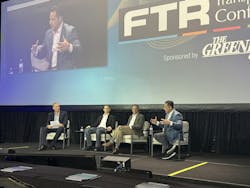EPA27 isn’t dead yet. Will your fleet be prepared?
Key takeaways
- EPA27 mandates a significant reduction in NOx emissions for heavy-duty trucks starting in 2027, with costs potentially increasing by over $20,000 per vehicle.
- The EPA is currently reevaluating the regulation, leading to uncertainty and delaying fleet procurement decisions as OEMs prepare compliant models for the upcoming model year.
- Market factors like tariffs and flat rates are already affecting OEM production and fleet purchasing, emphasizing the need for strategic planning in an uncertain regulatory environment.
INDIANAPOLIS—While fleet owners and truck buyers might have been able to ignore EPA27 woes over the summer, the deregulation-focused Environmental Protection Agency (EPA) has offered no updated guidance on the regulation’s fate—and the clock is ticking.
This time a year ago, the 2027 prebuy was one of the hottest topics in the industry. Yet after the presidential election, the conversation changed. Instead of talking strategy about vehicle acquisition and prebuy, the industry celebrated the hope that the Trump administration would eliminate or postpone the regulation predicted to cause the cost of model year 2027 trucks to skyrocket.
The regulation in question is part of the EPA’s Clean Truck Plan and requires all heavy-duty trucks model 2027 and later to emit no more than 35 milligrams of NOx per horsepower-hour (the current regulation is 200 milligrams per horsepower-hour). To meet these standards, OEMs anticipate equipment costs to soar—upwards of $20,000—due to the cost of complex components, aftertreatment systems, and a required increase in the vehicle’s warranty period.
While the rule is technically final, the Trump administration is “reevaluating” it, the EPA announced on March 12. Since then, truck manufacturers kissed the prebuy goodbye—which many predicted would have begun already.
With 2027 less than 18 months away, industry leaders are warning trucking companies not to get comfortable—at least not yet. Paul Rosa, SVP of procurement and fleet planning at Penske, believes that even if the “goal post is moving” regarding emissions regulations, that doesn’t change the outcome; it only changes fleets’ decision-making process.
"The most important thing that we're trying to do is to be as prepared as we can possibly be,” Rosa said, “because if you're not prepared when a decision is finally made, boy, you could be in a tough spot.”
Rosa offered this insight as part of a discussion on the status of emissions regulations at the 2025 FTR Transportation Conference here in Indianapolis. Both Rosa and Sean Waters, VP of compliance and regulatory affairs for Daimler Truck North America, took a conservative approach to the pending emissions regulations changes, signaling that the industry cannot afford to ignore potential procurement disruptions if the decision to eliminate, amend, or push EPA27 is not made soon.
“If [EPA27] is going to go into effect as it's scheduled to go into effect, we're running out of time for that decision to be known and for fleets to make a decision,” Rosa said, noting that in a few short weeks, OEMs will begin the production of their MY 2026 vehicles, leaving fleets just one year to plan their truck acquisitions before MY 2027 vehicles.
Until EPA announces otherwise, EPA27 is the law
Truck OEMs are currently bound to the regulations that are in front of them, and because EPA27 is still law, truck makers must be ready to provide model year 2027 vehicles that meet EPA27 standards.
“The first and most important thing the OEMs have been doing for the last five to seven years is getting ready for the 2027 NOx standards,” Daimler’s Waters said. “We have a product that we've been developing that we're very confident in, and we are prepared to meet the 2027 standards with very good technology that we think is going to add a lot of value to our customers.”
Daimler isn’t alone. Multiple truck makers and engine suppliers have announced the development and, in some cases, the validation of these new models that are on track to begin selling within the next year.
Unfortunately for truck buyers, it might be a bit too late for the EPA to throw out EPA27 altogether. As Waters stated, equipment development takes years, and “there's not supposed to be changes to any emission regulations without four years’ lead time,” he said.
He believes the change most likely to occur with EPA27 would be with the warranty requirements, which increase from 435,000 miles to 650,000 miles with the current EPA27 rule.
"This is an opportunity that we think EPA should take advantage of and go back to the prior warranty provisions that we've had before—that we've always had in this space—because it's an opportunity to take some cost out of that 2027 product,” Waters said.
Until the EPA announces concrete changes or a pause to EPA27, the time to prepare for the future is now. Tariffs impact the cost of vehicle production. Flat rates impact fleets’ bottom lines and cause them to delay their truck purchases. Together, these factors have slowed OEM production, as noted by FTR’s data, which could prevent OEMs from being able to meet fleets’ demand as we inch closer to 2027.
“Fleets have to be prepared; you could be left behind,” Rosa said. “What is your strategy?”
The latest on EPA27
It is worth noting that other truck manufacturers have signaled a possible delay, and industry organizations have also taken action in hopes of persuading the EPA to delay the rule.
Earlier this summer, FleetOwner reported that leadership at Traton SE, the parent company of International and Scania trucks, believe that there is a high possibility that the rule will not go into effect by January 1, 2027, citing the lack of certainty surrounding the regulation.
“We do not yet really know towards what level of NOx we need to type-approve our engines,” Traton SE CEO Christian Levin said. “That’s why I say it’s highly unlikely that there will be any prebuy this year and why there could be a delay of the introduction because this is not making any sense.”
In the meantime, the American Trucking Associations and other trucking organizations requested the EPA delay the start of the low NOx requirement by four years, from 2027 to 2031.
“The heavy-duty NOx rule imposes substantial compliance costs and operational burdens at a time when the trucking industry is already contending with historically difficult market conditions," ATA wrote in a letter to the EPA. "With prolonged weakness in freight demand and inflationary cost pressures, the rule’s 2027 implementation timeline threatens to intensify strain across our industry."
While uncertainty surrounds trucking emissions policy, the fact remains that the government still considers the EPA27 rule final.
About the Author
Jade Brasher
Senior Editor Jade Brasher has covered vocational trucking and fleets since 2018. A graduate of The University of Alabama with a degree in journalism, Jade enjoys telling stories about the people behind the wheel and the intricate processes of the ever-evolving trucking industry.




